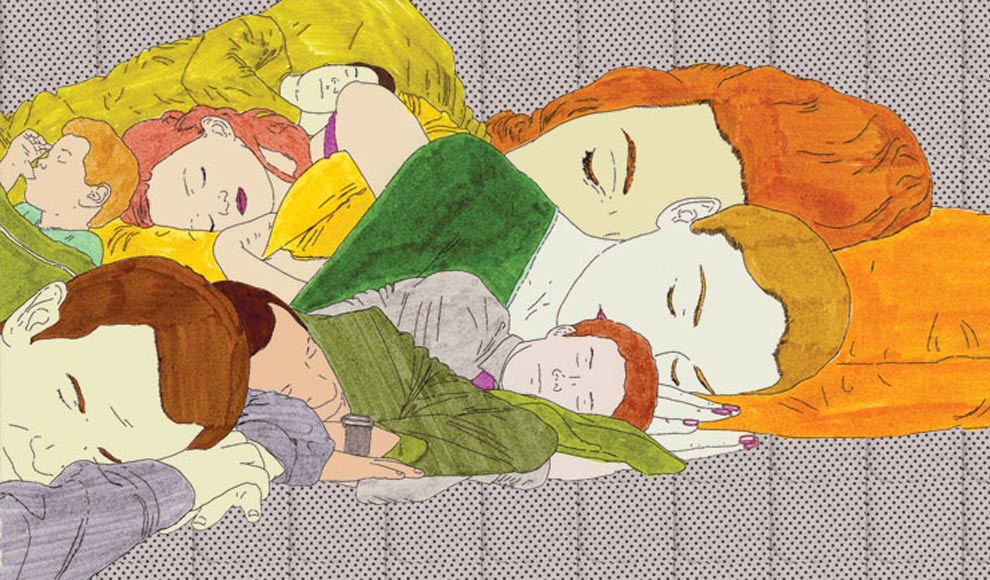From the supernatural premonitions recounted in religious scriptures to Sigmund Freud’s theory of the unconscious, from the simplest bedtime stories we tell our children to the countless sophisticated depictions in literature and cinema, sleep has long beguiled our imagination. Today, journalists and therapists tout the “power of sleep,” while scientists endeavor to unlock the enduring mysteries of an activity that human beings share with fruit flies and sea lions, mice and elephants.
Yet, despite all that has been written on the subject and all the effort devoted to studying the phenomenon scientifically, we do not have a clear answer to a question that would seem to be central to understanding the human experience: “Why do we sleep?”
To answer that we need to first ask what sleep is, and what its essential characteristics are. We know that it is probably evolutionarily conserved, meaning that it has persisted throughout evolutionary history ever since it first evolved. Many scientists also think it is universal among animals, though it has been studied systematically only in a small number of species. Sleep may show up under different guises in different species. Dolphins, for instance, may be able to sleep “unihemispherically” — falling asleep with one half of their brains while the other half remains awake. This allows them to perform complex activities, such as swimming to the surface of the ocean to breathe, without waking up. The nematode worm C. elegans enters into a sleep-like lethargus before molting. In many species, including humans, sleep is generally associated with certain postures, such as lying down, and immobility.
It’s not as easy as you might think to tell if an animal is sleeping. A crude but effective way is to test if an animal is “disconnected” from its environment by providing some stimulation that would typically provoke a strong reaction, such as an unexpected noise. If the animal does not react, there is a good chance that it is genuinely disconnected — and thus sleeping, rather than merely resting. Scientists consider such a reversible disconnection from the environment to be a defining feature of sleep. (An irreversible disconnection from the environment would be a coma.)
Why would animals periodically disconnect from the environment?
One answer offered by biologists is that sleep has no vital function or purpose of its own. This is sometimes called the “null hypothesis” for sleep. Defenders of this view maintain that, unlike eating or reproducing, sleeping is not itself necessary for survival but is useful insofar as it helps animals to avoid predation or to regulate their metabolic rates. Such periods of quiescence may have been naturally selected for because they are conducive to survival by forcing the animal to hide for periods of time. What is essential about sleep, according to this view, is that the animal avoid danger and decreases (temporarily) its use of metabolic resources.
The problem with the null hypothesis is that it has all the hallmarks of a “just-so story.” One could easily turn the reasoning on its head: Doesn’t regularly disconnecting from the environment for a significant portion of time make an organism more vulnerable to predation, not less? Wouldn’t time be better spent on activities that are essential for survival, such as mating, or collecting food or other resources? And if hiding or resting is, evolutionarily speaking, just as good as sleeping, why do so many animals sleep?
If the null hypothesis is wrong, then perhaps sleep does have some essential function.
When I was an undergraduate, a neuroscience professor gave me the following instruction: learn to juggle in a day. I spent the rest of the afternoon, evening, and much of the night in my dorm room trying to figure it out — hours and hours, until finally, closer but still unsuccessful, I crashed into my bed. When I woke up the next morning, I tried again, and lo and behold, I could juggle effortlessly. It felt like magic.
Because of such well-known behavioral effects, neuroscientists have focused on the benefits of sleep for learning and memory. Some speculate that sleep has a special role to play in consolidating and storing memories. One hypothesis is that sleep allows the brain to replay memories in certain structures, such as the hippocampus, thus consolidating those memories. Research on the hippocampus and other regions of the brain, for example the primary visual cortex, suggests that the kind of neural activity that occurs during sleep is in some ways similar to the neural activity that occurred during learning.
However, it’s experimentally difficult to differentiate between a replaying memory and simple background neural activity. Conceptually speaking, it’s like trying to find the shapes of clouds within other clouds. And in any case, replaying memories to consolidate them further hardly seems like the kind of essential function that would explain why sleep is so common, even universal, in the animal kingdom.
Still, learning, memory, and cognitive ability seem to be promising areas for trying to find an essential function of sleep. One recent proposal that attempts to draw these areas together into a single whole is the Synaptic Homeostasis Hypothesis (SHY), originally put forward by Giulio Tononi and Chiara Cirelli in 2003. (Full disclosure: I did my doctoral research in Tononi and Cirelli’s Center for Sleep and Consciousness at the University of Wisconsin–Madison, though SHY was not my focus.)
To my mind, SHY stands apart from other scientific hypotheses about sleep because of its scope and its explanatory elegance. And, despite the fact that elegance is an important feature of scientific theories, there are surprisingly few elegant theories in neuroscience. This may be because so many neuroscientists treat the brain as a modular kludge, focusing on one specific part of the brain as pertaining to their research specifically. SHY, by contrast, is about neural networks in general.
The point of departure for SHY is a refrain that is familiar to all neuroscientists: “neurons that fire together wire together.” This phrase is commonly used to summarize a notion advanced by Donald Hebb in his 1949 The Organization of Behavior. Hebb offered an explanation of what is now called synaptic plasticity — that is, how synapses grow weaker or stronger depending on how often they get used. The core idea is that if neuron A causes neuron B to fire, the next time neuron A fires, it is even more likely to cause neuron B to fire — what is now known as Hebb’s law. It is widely believed that such synaptic plasticity underlies by and large all learning and memory.
But there is a lesser-known implication of the law: If neurons continue firing together, and thus wiring together, creating stronger and stronger connections, then wouldn’t all of the connections eventually become too strong, such that any one neuron could set off a kind of chain reaction through the entire neural network, perhaps even triggering an epileptic fit?
In fact, scientists know that neurons do not always grow stronger through repeated use but can, under the right circumstances, also grow weaker through learning. However, making a neuron fire is more information-rich than keeping a neuron from spiking. So one might expect neural connections to grow stronger generally during learning. An important prediction of SHY is that, on average and over time, neural connections do indeed grow collectively stronger during periods of active learning, which can only occur when an organism is not disconnected from its environment — when it is not sleeping. This means that there is a net increase in synaptic strength during waking hours; the longer you are awake, the stronger your synapses become (generally speaking). It follows that if you were to stay awake long enough, you would run into all sorts of problems: your neurons would saturate, meaning they would no longer be able to acquire new information; the metabolic energy cost of maintaining synapses would become exorbitantly high; and it would become increasingly difficult to respond to neural signals. In short, you would be unable to learn.
SHY proposes that the essential function of sleep is to regulate synapse strength in the brain, allowing us learn during the day. “Sleep is the price the brain pays for plasticity,” as Tononi and Cirelli put it. Specifically, this means that during sleep the synapses are “downscaled” back to the same overall strength they had in their starting state (at the beginning of the day). Maintaining “synaptic homeostasis” in this way keeps synapses from getting too strong, thereby preventing neuron saturation, reducing the amount of metabolic energy the synapses use, and increasing the ratio of neural signals (memories) to noise.
Note that it is the overall strength of the synapses that gets downscaled. It is not as though individual synapses simply revert back to their initial states. That would be counterproductive for learning. Tononi’s and Cirelli’s insight is that what matters for memory is the relative strength of neurons across the entire neural net, not the strength of individual synapses.
If SHY is correct, the reason I woke up able to juggle is that the neural connections from all that repetition were forged before I went to bed. But since the delicate neural connectivity pattern was swamped by the noise of so many other synapses while I was awake, it did not yet translate into a new skill. Sleeping allowed my brain to uncover that connectivity, like sunken architecture being revealed as the tide goes out.
How does the process of downscaling synaptic strength work? We don’t know exactly. There’s some evidence that what are called “slow waves” in deep sleep play an important role. Perhaps slow-wave sleep prunes the overgrown neural garden of the brain. But SHY is neutral as to the precise nature of the neuronal mechanism responsible for downscaling — which, for all we know, might vary across animal species.
Of course, not all scientists who study sleep accept SHY as the best explanation of sleep’s essential function. While SHY is compatible with experimental evidence, much more research is still needed. A potential obstacle is that neuroscientists are often more interested in the local mechanisms of neural activity than the kind of high-level abstractions offered by SHY.
But the very fact that scientists today disagree about why we sleep — why we live out but two-thirds of our lives, and spend the other third disconnected from our environment — is a humbling reminder of how much we still do not know.
Discussion Questions:
- Is there a good universal definition of sleep? Does the scientific description offered here — thinking of sleep as a reversible disconnection from the environment — capture our commonsense intuitions about the nature of sleep?
- What do you think of the Synaptic Homeostasis Hypothesis (SHY)? Do you find it elegant, as I do?
- Relatedly, I noted that elegance is an important feature of scientific theories. Do you agree?
- In my essay, I mostly talked about deep, dreamless sleep. But dreaming occupies a significant portion of our time as well. Why might we dream? How might dreams fit into the explanations for sleep that SHY proposes? Is dreaming as necessary as dreamless sleep?
- My focus was mostly on the neuroscience of sleep. Can you think of other functions of sleep besides the ones discussed in the essay?
Discussion summary
This essay explored a fundamental aspect of biology, sleep, the purpose of which is still largely unknown. One of the difficulties is that sleep appears universal across species, so any explanation of sleep needs to explain this universality — why sleep is found not only in humans but across the entire animal kingdom, from fruit flies to lizards.
Recently, researchers have looked to sleep’s role in learning and memory as a possible explanation. I suggested that the most intriguing hypothesis in this area is the Synaptic Homeostasis Hypothesis (SHY), which proposes that sleep is necessary to maintain synaptic homeostasis. The idea is that during daytime learning neurons generally form stronger connections and then are pruned back to an average baseline level during sleep. In this way, only the strongest neural connections survive the night, weeding away unnecessary connections and thus the saturation that occurs from staying awake too long.
In our discussion, several people agreed with me that one of the benefits of SHY is that it is elegant and provides, at least potentially, an explanation for the universality of sleep. There also seemed to be agreement that there is no necessary conflict between SHY and memory replay accounts of sleep. For instance, during NREM (or dreamless) sleep, there could be a generalized downscaling of synapses, but then dreams might either add noise to the system, or replay memories to strengthen back the required synapses.
I’m not convinced that memories are ever replayed since the evidence doesn’t seem to support such claims. I do, however, agree with some commenters who suggested that dreaming acts as a kind of general-purpose simulator. This keeps the system from settling down on any local minima. Thus I brought up the notion of simulated annealing and also suggested that dreaming is a metaheuristic that allows neural connectivity to approximate the global optimum of a given function.
Other readers raised questions about the consequences of SHY, assuming it turns out to be true. Might SHY explain sleep disorders, for example? This is still an open question. However, most sleep disorders are generally about two things, as was noted in the discussion: difficulties transitioning between states (such as insomnia and sleep paralysis); or problems with disconnecting from the environment (such as sleepwalking and sleep-eating). In neither of these cases is there a malfunctioning of the intrinsic cortical process. Instead, the difficulty is in achieving the sleep state or, alternatively, the sleep state has unintended consequences because the organism is inappropriately connected to its environment at a time when it shouldn’t be. This suggests that while SHY may be great at explaining normal sleep, general sleep disorders may be beyond its explanatory purview.
Ultimately, as a promising young theory, the fate of SHY will come down to experimental evidence. As one commenter pointed out, it’s going to require showing that SHY applies similarly to all animals, not just humans. Only then could it be considered as having provided an explanation of the universal function of sleep.
New Big Questions:
- How can one empirically dissociate SHY from other learning and memory explanations of sleep?
- Is there really one answer to the question “why do we sleep?” What if, instead, there are dozens of built-upon biological mechanisms and processes that over-determine the necessity for sleep?












Great post. Elegance is an essential characteristic of good science. This theory is elegant. Now the challenge is to prove it is true.
As for dreams, my completely uneducated, personal experience based speculation is that dreams are related to resolving emotional issues.
Something is going on at the biochemical level in the central nervous system with sleep. But no one has any idea what it is.
What makes me curious is the fact that sleep is necessary, that you will die without it. Why?
I don’t think anyone knows precisely what causes death from lack of sleep. I once heard an account that people had tried limiting specifically the REM sleep (dreaming) of rats by constantly waking them but *only* when the rats were dreaming (not in NREM sleep). Eventually the rats died from lack of dreaming. One thing for sure is that sleep deprivation messes up your metabolism, and it’s a huge stressor. Additionally, the severely sleep-deprived often get seizures (which fits in well with SHY, as seizures could be caused by a synaptic build-up).
A different theory for the role of sleep which I originally proposed in 1990 (Pattern Thinking, Praeger/Greenwood) is that memories of all types often require new connections between neurons. However, there isn’t time to create new axons and synapses “on-the-fly” when needed. As a result, the brain creates provisional synapses (probably silent) that are available if needed. Such provisional synapses could be created at random, but this would lead to large numbers of irrelevant synapses. The brain cannot “know” exactly which connections will be needed, but the best available estimate is between neurons that have been active at the same times in the past. In other words, using past experience as the best available guide to the probable future, with recent experience on average being better than more distant.
So the brain performs a rapid rerun of samples of past experience, with a bias in favour of more recent, and makes provisional connections between neurons often active at the same time during this rerun. Such a rerun would be very confusing to the processing of current experience, so the brain is taken off line.
Electronic simulations indicate that the number of connections needed to support the same learning is reduced by about 20%
Interesting! I didn’t know about this – I’ll have to check out the paper. I actually had a similar speculation a while back when I was thinking about simulated annealing: during sleep or dreaming there could be an overgrowth of new random connections that keep the system from getting stuck in local learning minima. Basically then sleep (or parts of sleep) would keep the brain from overfitting in its learning.
In addition to Pattern Thinking, a 2001 paper that includes a description of the idea and some simulations is available at http://users.cecs.anu.edu.au/~Andrew.Coward/Lessons.pdf
My most recent book which also refers to the idea is Towards a Theoretical Neuroscience (Springer 2013)
Interesting, thank you. Speculating on the possible function of dreaming, if any exists, it may help to limit the downscaling of synaptic strength to those connections that form the noise, while leaving the connections that are part of a real memory intact (ie not downscale the strength of those connections as much as the irrelevant ones). Repeating a desired memory over and over during a dream then serves to identify the connections associated with that memory by continuesly activating them during the downscaling process.
Note that this hypothesis also provides a link with the memory hypothesis.
How is the idea of the Synaptic Homeostasis Hypothesis related to evolution? Couldn’t there be a broader evolutionary explanation of sleep that is compatible with SHY? It seems like regulating synapse strength would have evolutionary advantages…
I definitely think the general idea was to search for something so broad, so universally needed, that it would account for sleep’s near universality. SHY offers a hint of that because it proposes that all neural networks, in order to learn, need to maintain synaptic homeostasis. It’s true that regulating individual synaptic strengths have evolutionary advantages: that’s basically all of learning! But maintaining synapses, rather than changing them, has gotten less attention. SHY finds its evolutionary place by focusing on this maintenance.
Why don’t all neuroscientists accept SHY? Are their objections empirical? Or do they just prefer narrower lines of explanation?
Some of the objections are empirical just in that there’s not overwhelming evidence for it. I do think most neuroscientists are geared toward more narrow, purely biological, explanations, and I don’t think SHY is the only theory that suffers from it. In fact, neuroscience has a theoretical dearth right now – career-wise the field is very empirically driven, and so the tools shape the questions in those kinds of fields.
So, you talked about dolphins, and how weirdly they sleep. And presumably other animals sleep in very different ways, too. (I think my cats, for instance, always sleep on a sort of hair-trigger, so they can wake up and chase prey whenever it walks in front of them, so they sleep lightly but they sleep something like 17 hours per day.) So then, if dolphins (and cats, and other animals) sleep very differently from us, how does SHY apply to these other animals? Or does it? Or do we just not know at this point?
Also, a related question: I don’t know if you’re old enough to remember the days when computers had to be “defragmented,” but when I read your piece about SHY, that’s what I immediately thought of. Is that a good analogy to describe the kind of synaptic “downscaling” you’re talking about?
To your first question: we don’t know at all! I think researchers have only looked for evidence for SHY in a handful of species like mice, rats, and humans, but we don’t have any idea about other ones. The interesting thing about SHY is that because it’s aiming for a universal function of sleep, if you could find one animal that did sleep regularly but showed no evidence for maintaining synaptic homeostasis during sleep, that’d be good evidence that the theory isn’t true.
As to your second question: I like the defragmentation metaphor! In a sense it’s right because defragmenting is a kind of restructuring. But in SHY the restructuring is totally equal: all synapses are reduced to some degree during sleep, but their proportionality is kept. In defragmenting memories are actually moved around to be in a better order for access. I’d actually say defragmenting is closer to the hypothesis that memories “move” during sleep, or get replayed and directly and individually reorganized. So it’s definitely in the field.
As an observer with witnesses: there is sleep-walking, e.g. walking down stairs making a turn at the floor stepping to the piano-bench, sitting and then playing, all while sleeping; there is conscious out-of-body experiences that I had personally, while sleeping. And there is the related sleep-paralysis where upon waking, speech is inhibited.
That makes me wonder (and maybe this is what the previous commenter was getting at too): does SHY tell us anything about sleep-related behaviors like sleepwalking or sleep-eating or sleep-related disorders like insomnia? Could it be that people who have trouble sleeping aren’t getting the synapse downscaling they need, or some such?
Good question. I think SHY conceptually separates out sleep in a useful way: it dissociates the lack of responsivity to the environment, the offline nature of sleep, from sleep itself. So sleepwalking would be a problem of whatever is supposed to block off input/output (and people are now looking into this).
In general I don’t think SHY has been used to try to find etiologies for sleep disorders yet. And SHY theorizing focuses only on normal, healthy brains. But I think there is supporting evidence for SHY in insomnia, where there are clear cognitive deficits from staying awake too long. I think a possibly really good test for SHY would be to induce a disorder. Basically, keep someone awake for a long time and see whether or not sleep deprivation leads to memory confusion: that is, whether or not your associative networks themselves become saturated just like your neural networks do.
A well-written, fascinating and absorbing article, as usual.
So I have a few questions.
Could SHY be related to a change in the perception of time as one grows older? Compared to when I was young, time seems to have greatly accelerated. If neuronal connections gradually grow stronger during learning, might they also grow smarter over time in their ability to access memories? When young many experiences are unique and new, causing the brain to develop many complex structures to store and retrieve them. But during the aging process more and more memories are just repetitions of previous experiences already stored someplace. If the brain becomes expert over time in consolidating and storing these memories the older you are, then what you might be experiencing in consciousness is that the brain doesn’t have to perform the same repertoire of neuronal connections, but instead relies more on some kind of efficient proxy memory function that will do the trick faster with less metabolic cost, thus affecting one’s perception of experience over time? In other words, is your perceived time of the act of learning to juggle any different than your perceived time of the act of juggling the next morning? How can this difference be measured?
As a human, I can’t separate sleep from dreaming. Since our brain is responsible for interpreting everything in our world, how our brain does this is responsible for the overall success of our species. Still, from my understanding of amateur science, the world is a construct of our functioning brain. During sleep the brain is stimulated not from our senses, as when we are conscious, but creates the stimulation during dreams. Or perhaps AS dreams. But these dreams are invariably a story line. I have read that some scientists have put probes into rat brains that measure brain activity and then ran the rats in a maze. When they took pictures of the brain activity of the conscious rat in the process of running the maze and compared it to the sleeping/dreaming rat, the activity was essentially identical. This is doubtless advantageous for the rat in learning and remembering complex tasks that aid its daily survival. But how do I interpret dreams that do not seem to have any association with experienced reality?
I had a dream once that I was sitting in a small cafe with a few friends. Suddenly a huge buffalo entered the room, walked slowly over to me and put its forehead against mine. It breathed out a long slow breath directly into my face. Its breath was cool and sweet and I felt no fear, but a great peace and sense of belonging came over me. It was like inhaling pure oxygen. This story line does not seem to have any direct relationship to what I ever experienced in my conscious life, and yet I believe that it has a great relevance to my existence–more of an abstract knowing than a direct line that connects it to a particular experience. How does neuroscience attempt to explain human dreams that seem to be generated outside any accepted reality of human consciousness? Indeed, the dream state may exist independent of known human behavior or even Newtonian physics (flying, morphing into something or someone else, etc.). This seems to be a far different world than the rat dreaming of running a maze.
Thank you for your consideration.
I’d say that what you outlined in your first paragraph is very close to current standard thinking in the field. In the sense that SHY does facilitate learning, it should be related to the loss of time perception in age. However, there’s always the possibility of learning new things – as long as neural networks are kept away from steady states they should keep laying down thick memories.
Humans and reptiles both (it was just reported that lizards dream). Dreams probably don’t have a strong relationship to real life, most of the time. Rather, they are for exploring the state space of possible conscious experiences. This, I’d advocate, injects noise into neural networks and thus allows them to form new associations that can be capitalized later on during wake. And that’s probably why sometimes people can have very strange or surreal dreams – it’s your brain making “leaps of faith” that waking experience can capitalize on later.